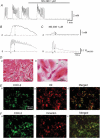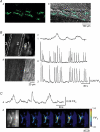Interaction between interstitial cells and smooth muscles in the lower urinary tract and penis
- PMID: 16945972
- PMCID: PMC1890411
- DOI: 10.1113/jphysiol.2006.116632
Interaction between interstitial cells and smooth muscles in the lower urinary tract and penis
Abstract
Smooth muscles in the lower urinary tract and corporal tissue exhibit spontaneous contractile activity which depends on L-type Ca(2+) channels. The mechanism underlying this activity is spontaneous electrical activity which shows varied form and property between these tissues. Recent studies revealed that interstitial cells (ICs) are widely distributed in the genitourinary system, and suggested their involvement in spontaneous muscle activity. ICs in the system are not a simple analogy of interstitial cells of Cajal (ICC) in the gut, which act as electrical pacemaker, but represent variability amongst tissues which may account for individual characteristics of each organ. In the bladder and corporal tissue, where smooth muscle cells are capable of generating spontaneous electrical activity, ICs may modulate smooth muscle activity. ICs in corporal tissue release prostaglandins via cyclooxygenase-2 (COX-2) activity and reinforce not only spontaneous but also nerve-mediated alpha-adrenergic contractions. In the bladder, their fundamental role in the integration of signals between populations of cells has been proposed, and thus changes in ICs may contribute to an overactive bladder, a pathological condition which results from increased excitability in detrusor smooth muscles. In the urethra, ICs may act as electrical pacemakers as do ICC. However, overall contractility of urethral smooth muscles does not necessarily rely on pacemaking of ICs, and thus some population of smooth muscles may also have their own excitability.
Figures




Similar articles
-
Mechanisms of Disease: specialized interstitial cells of the urinary tract--an assessment of current knowledge.Nat Clin Pract Urol. 2005 Nov;2(11):546-54. doi: 10.1038/ncpuro0340. Nat Clin Pract Urol. 2005. PMID: 16474598 Review.
-
The physiological function of lower urinary tract smooth muscle.Auton Neurosci. 2010 Apr 19;154(1-2):3-13. doi: 10.1016/j.autneu.2009.10.006. Epub 2009 Nov 24. Auton Neurosci. 2010. PMID: 19939745 Review.
-
Organization and function of ICC in the urinary tract.J Physiol. 2006 Nov 1;576(Pt 3):689-94. doi: 10.1113/jphysiol.2006.116657. Epub 2006 Aug 17. J Physiol. 2006. PMID: 16916908 Free PMC article. Review.
-
Identification of interstitial cells of Cajal in corporal tissues of the guinea-pig penis.Br J Pharmacol. 2004 Jan;141(2):199-204. doi: 10.1038/sj.bjp.0705622. Br J Pharmacol. 2004. PMID: 14751868 Free PMC article.
-
Interstitial cells of Cajal in the urinary tract.Handb Exp Pharmacol. 2011;(202):233-54. doi: 10.1007/978-3-642-16499-6_11. Handb Exp Pharmacol. 2011. PMID: 21290229 Review.
Cited by
-
The actions of prolonged exposure to cholinergic agonists on isolated bladder strips from the rat.Naunyn Schmiedebergs Arch Pharmacol. 2015 Jul;388(7):737-47. doi: 10.1007/s00210-015-1129-y. Epub 2015 May 17. Naunyn Schmiedebergs Arch Pharmacol. 2015. PMID: 25980359
-
Properties of spontaneous Ca2+ transients recorded from interstitial cells of Cajal-like cells of the rabbit urethra in situ.J Physiol. 2007 Sep 1;583(Pt 2):505-19. doi: 10.1113/jphysiol.2007.136697. Epub 2007 Jul 5. J Physiol. 2007. PMID: 17615099 Free PMC article.
-
β-Adrenoceptor-mediated Relaxation of Urinary Bladder Muscle in β2-Adrenoceptor Knockout Mice.Front Pharmacol. 2016 May 9;7:118. doi: 10.3389/fphar.2016.00118. eCollection 2016. Front Pharmacol. 2016. PMID: 27242525 Free PMC article.
-
Potentiation of carbachol-induced detrusor smooth muscle contractions by beta-adrenoceptor activation.Eur J Pharmacol. 2009 Mar 15;606(1-3):191-8. doi: 10.1016/j.ejphar.2009.01.034. Epub 2009 Jan 29. Eur J Pharmacol. 2009. PMID: 19374847 Free PMC article.
-
Role of KIT-Positive Interstitial Cells of Cajal in the Urinary Bladder and Possible Therapeutic Target for Overactive Bladder.Adv Urol. 2011;2011:816342. doi: 10.1155/2011/816342. Epub 2011 Jul 17. Adv Urol. 2011. PMID: 21785586 Free PMC article.
References
-
- Azadzoi KM, Kim N, Brown ML, Goldstein I, Cohen RA, Saenz De Tejada I. Endothelium-derived nitric oxide and cyclooxygenase products modulate corpus cavernosum smooth muscle tone. J Urol. 1992;147:220–225. - PubMed
-
- Biers SM, Reynard JM, Doore T, Brading AF. The functional effects of a c-kit tyrosine inhibitor on guinea-pig and human detrusor. BJU Int. 2006;97:612–616. - PubMed
-
- Bivalacqua TJ, Champion HC, Usta MF, Cellek S, Chitaley K, Webb RC, Lewis RL, Mills TM, Hellstrom WJ, Kadowitz PJ. RhoA/Rho-kinase suppresses endothelial nitric oxide synthase in the penis: a mechanism for diabetes-associated erectile dysfunction. Proc Natl Acad Sci U S A. 2004;101:9121–9126. - PMC - PubMed
-
- Brading AF. A myogenic basis for overactive bladder. Urology. 1997;50:57–67. - PubMed
-
- Brading AF, McCloskey KD. Mechanisms of disease: specialized interstitial cells of the urinary tract – an assessment of current knowledge. Nat Clin Pract Urol. 2005;2:546–554. - PubMed
Publication types
MeSH terms
Substances
LinkOut - more resources
Full Text Sources
Other Literature Sources
Research Materials
Miscellaneous

